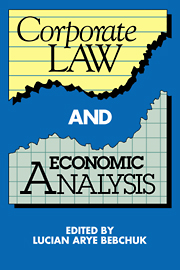Book contents
- Frontmatter
- Contents
- List of contributors
- Introduction
- Acknowledgments
- 1 Mergers, acquisitions, and leveraged buyouts: an efficiency assessment
- 2 Discounted share prices as a source of acquisition gains
- 3 Ties that bond: dual class common stock and the problem of shareholder choice
- 4 Property rights in assets and resistance to tender offers
- 5 A new approach to corporate reorganizations
- 6 The corporate contract
- 7 The state competition debate in corporate law
- 8 The positive role of tax law in corporate and capital markets
- 9 Ownership of the firm
- Index
9 - Ownership of the firm
Published online by Cambridge University Press: 15 December 2009
- Frontmatter
- Contents
- List of contributors
- Introduction
- Acknowledgments
- 1 Mergers, acquisitions, and leveraged buyouts: an efficiency assessment
- 2 Discounted share prices as a source of acquisition gains
- 3 Ties that bond: dual class common stock and the problem of shareholder choice
- 4 Property rights in assets and resistance to tender offers
- 5 A new approach to corporate reorganizations
- 6 The corporate contract
- 7 The state competition debate in corporate law
- 8 The positive role of tax law in corporate and capital markets
- 9 Ownership of the firm
- Index
Summary
Introduction
Most large-scale enterprise in the United States is organized in the form of the conventional business corporation, in which the firm is collectively owned by investors of capital. Other ownership patterns are prominent in a number of important industries, however. Many firms, for example, are owned by their customers. These include not just consumer retail cooperatives, which are relatively rare, but also business-owned wholesale and supply cooperatives, which are quite common, as well as public utility cooperatives, mutual insurance companies, mutual banking institutions, and cooperative and condominium housing. Further, many firms are owned by persons who supply the firm with some factor of production other than capital. Worker-owned firms, which predominate in professional services such as law and accounting, are conspicuous examples, as are the agricultural processing and marketing cooperatives that dominate the markets for many farm products. Finally, a number of important service industries are heavily populated by nonprofit firms, which have no owners at all. In this essay I explore the economic factors responsible for these different patterns of ownership.
In recent years a number of scholars have explored various aspects of enterprise ownership. In particular, Williamson and Klein, Crawford, and Alchian have dealt insightfully with the influence of transactionspecific investments on the assignment of ownership, and I shall draw heavily here on the concepts they have developed. Similarly, a number of writers have looked at questions of ownership in particular contexts.
- Type
- Chapter
- Information
- Corporate Law and Economic Analysis , pp. 281 - 314Publisher: Cambridge University PressPrint publication year: 1990
- 5
- Cited by



